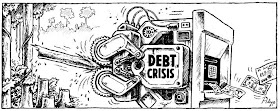No surprise also that we see spiralling levels of personal, business and public debt. Neoclassical economists see no problem with this. On their planet, the creation of money in this way will be balanced out by a corresponding amount of econom
 ic growth. Apart from the obvious fact that money supply is growing far more rapidly than economic activity from a green perspective this growth itself is a problem. So the most important first step towards creating the steady state economy that will not put intolerable pressure on the carrying capacity of the planet is to change the system of money creation that generates the need for the growth.
ic growth. Apart from the obvious fact that money supply is growing far more rapidly than economic activity from a green perspective this growth itself is a problem. So the most important first step towards creating the steady state economy that will not put intolerable pressure on the carrying capacity of the planet is to change the system of money creation that generates the need for the growth.The discussion so far has been in terms of a national currency, but currencies are also exchanged and used to pay for exchanges of goods and services between national economies. This role is now played primarily by the dollar, which has acquired the status of international reserve currency since the agreement establishing the financial structure to dominate global capitalism after World War II. Under the Bretton Woods Agreement, the USA also extracted the right to have its currency—the dollar—considered the equivalent in terms of economic weight of gold reserves. In the post-war exhaustion, low morale and financial desperation of the other world powers the USA pulled off this extraordinary confidence trick which has enabled their dominance for the past fifty years but left us all with a teetering economic system. The coda to the story is that the USA proved itself incapable of maintaining the value of the dollar and, in the face of the need for massive liquidity resulting from the costs of war in Vietnam, Nixon ‘closed the gold window’ on 15 August 1971. This meant that dollars were now themselves no longer linked to the reserves in Fort Knox but floating free, and foreign Central Banks could no longer exchange their dollars for gold.
Global capitalism relies on one country’s currency to provide credibility for the system as a whole. Initially this role was undertaken by gold itself, as a commodity of real value, but the movement towards fiat money which went hand in hand with the capitalist expansion, meant that currencies rather than gold played this role. The reserve currencies—sterling, the dollar, the yen, and the euro—are all used to underwrite economic activity, but just as in banking there is a central bank so in the currency system there is a central currency and this is the currency of the most powerful player in the global economy—the global hegemon.
It is mainly its own credibility and that of its economy and military structure that guarantees the functioning of the international economy, but it needs its own back-up in the form of gold reserves. During its days of empire the UK played the role of preferred currency. At that time US bankers supported the pound, a fact that alienated those outside the charmed circle who could not understand why US gold was being used to support a foreign competitive economy. Similar questions were raised when Chancellor Gordon Brown sold 415 tonnes of the UK’s 715 tonnes of gold reserves in May 1999, reducing the official reserve percentage held in gold from 16.7 to 7 per cent, and substituting currency, a mixture of dollars, euros, and yen. This is a record low level of gold holdings compared with the 2000-2500 tonnes held between 1958 and 1965, most of which were sold during Britain’s financial crises of the late 1960s and early 1970s.
The may seem like technical stuff, but the central point is simple. The nature of money creation via bank debt is undemocratic and unsustainable. Money should be created by ourselves, as citizens, to facilitate necessary economic exchange. Neither we, nor our governments, should be required to borrow it from banks. The debts this create cripple lives and are also fuelling unsustainable economic growth.
and here I thought people who started bankd needed money(chits) or assets first
ReplyDeletethen they could lend money
Am I wrong??
your take on new banks opening and creating new money... is different
ReplyDeletesuppose you had one car maker in a country that made 10 million cars
open another plnat and now there would be 2 making 10 million each or would the two share the same 10 million car market??
how would opening a new bank double the money supply??
Originally there was 'fractional reserve banking' so that a deposit could be inflated ninefold by the bank. But this percentage has been relaxed so that, at least in the UK, the lending banks only need to show the central bank that they are being prudent. Apparently the effective reserve is now only half of one per cent.
ReplyDeleteTake a check from your bank manager
ReplyDeleteAny amount will do
http://www.txtapic.com/